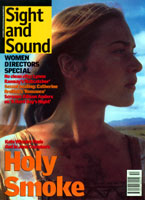Primary navigation

UK 1997
Reviewed by Philip Kemp
Our synopses give away the plot in full, including surprise twists.
Liverpool, 1964. Performing at the Jailhouse Club, Julie Carr and her backing group the Cadillacs - Tony, John, Jimmy and Roy - are invited down to London for an audition by PR agent Adam Schneider. Adam and his business partner Phil Green sign them up and introduce them to music publisher Cyril Wise. Waiting to cut their first single, the group hang out at a coffee bar where they meet songwriter Mike Williams working as a waiter. He and Julie are attracted, and start working on a song together.
The group cut a number for record company executive Mac MacDonald. Adam and Phil persuade them to use one of Mac's own songs as the 'B' side. At the last moment the disc is flipped to make Mac's mediocre number the 'A' side, and the record flops. While waiting to cut their second disc the group get casual jobs. Julie works as a waitress at a restaurant where Mike plays piano. Adam makes a pass at Julie, who rebuffs him. Discouraged, the Cadillacs return to Liverpool and Mike takes a job on a cruise liner, but Julie stays on in London.
Ten months later, Julie encounters Adam's former secretary Barbara, who quit in disgust and now runs her own talent agency. With her help and that of Cyril Wise, Julie relaunches her career. Mike returns from abroad for an emotional reunion with Julie. Adam and Phil, trying to muscle in on Julie's success, are sent packing. The Cadillacs are summoned back from Liverpool and, together with Julie and Mike, make a triumphant appearance on television.
"Let's do the Timewarp," sang Tim Curry's Frank N Furter with manic glee in The Rocky Horror Picture Show (1975). 'The Timewarp' might have been the ideal theme tune for Julie and the Cadillacs, which appears to have slipped through its own wormhole in space-time, a fluffily naive product of early 60s coffee-bar culture, unexpectedly dropped into the doped-up, cynical late 90s. Starry-eyed, amateurish and endearingly bouncy, Bryan Izzard's film constantly seems to be expecting Cliff Richard to show up in a red doubledecker.
For, unlike Rocky Horror or the musical Little Shop of Horrors, both of which pastiched bygone pop styles for their own spoof-satirical ends, Julie and the Cadillacs plays it straight. Neither the music nor the milieu are sent up; its portrait of the 60s music scene lacks the mordant edge of That'll Be the Day (1973) or Expresso Bongo (1959), let alone the sophistication of A Hard Day's Night (1964). In that neglected and largely despised genre, the British pop movie, this film's nearest relative would be some such uncomplicated celebration as The Young Ones (1961), which makes its emergence on the eve of the millennium all the more bizarre.
The explanation may lie with John Dean, who provides not only the script but all the music and lyrics. On this showing, words aren't his thing: the dialogue is cardboard and the lyrics woefully clunky. ("You must be the next to sign/Right there on the dotted line," sing the sleazy PR partners.) His ear for music is better attuned if confusingly eclectic, the pop styles ranging across all eras. As a post-Beatles Mersey group, the Cadillacs often sound more like early Stones or even Manfred Mann than Gerry and the Pacemakers, while in her solo numbers Julie veers from Shirley Bassey to Dusty Springfield, evoking odd echoes of the Everly Brothers when duetting with Mike.
Acting styles are likewise pick 'n' mix, with a cast of willing but bland youngsters leavened by such practised veterans as Thora Hird and Victor Spinetti, plus former New Wave icon Toyah Willcox, who seems to be metamorphosing into Barbara Windsor. Still, trouble has been taken over the production design; from Mike's quiff to the conical vomit-green coffee cups, all the props are assiduously in period. With no press showing and a minimal release, Julie and the Cadillacs will probably have vanished well before this review appears, but its eager retro amiability may earn it a small cult afterlife on video.